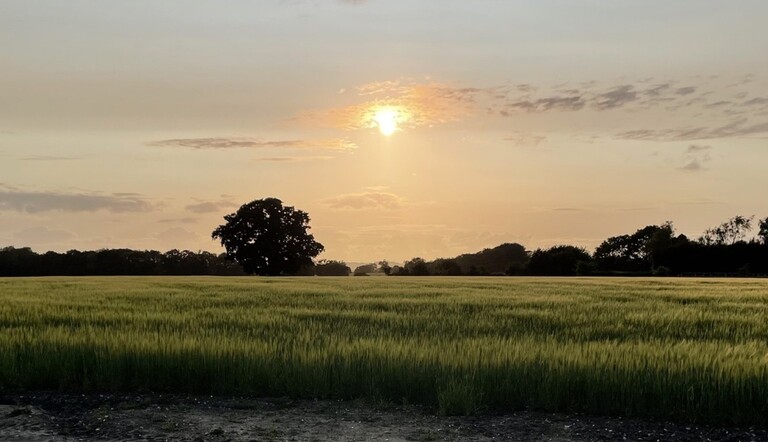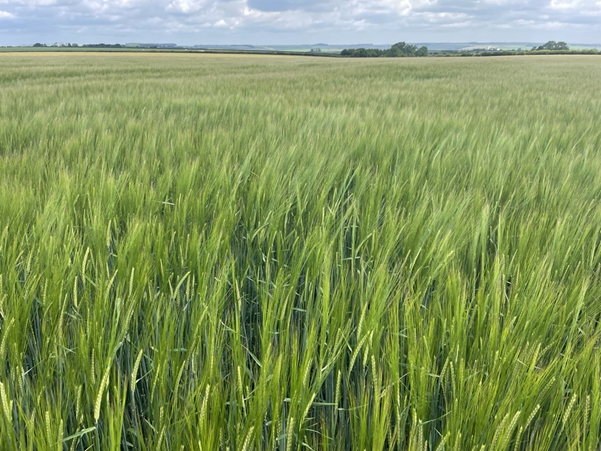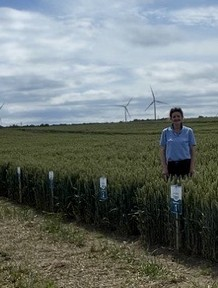
RAM Update

MICHAEL FARR
AGRONOMY MANAGER, SOUTH
As I sit here following a recent spell of 31oC heat, it is hard to believe that fields across the South of England were totally saturated last October and we didn’t know if or when winter crops were going to be drilled. Then, thankfully, conditions improved in November and drilling progressed at a pace with most farms ending ‘drilled up’.
So, while this late establishment had some downsides in terms of tillering and rooting, three factors gave the season a massive boost in terms of weed control:
1. Delayed drilling enabled multiple opportunities for glyphosate to be used after the peak of blackgrass and ryegrass emergence, with crops subsequently going into good stale seedbeds.
2. The moist and cooler conditions allowed residual herbicides to work well – not only in terms of efficacy against weeds, but also in terms of crop safety. The cooler conditions also helped with herbicide persistency.
3. At present the UK has access to a great range of residual herbicide actives which enable growers to apply a robust programme of pre- and post-emergence treatments (with cinmethylin based solutions appearing to give the best results on farm).

So, what about 2025? Although grass weed control has worked well, many crops are likely to pay a price because of a lack of tillers and poor rooting which will be exacerbated by the summer’s dry conditions. So, for many, going back to an earlier drilling window in ‘cleaner’ fields will be the go-to plan (unless, of course, mother nature has other ideas).
If drilling is delayed again this year, a one-shot weed control strategy can work well, but in earlier drilling scenarios herbicide programmes will need to provide greater persistency. In this scenario, a stacked programme of pre- and post-emergence treatments will be key. Multiple applications also enable different modes of action and actives to be applied.
Most programmes will be based on two key actives, cinmethylin and aclonifen, but growers should also consider including pendimethalin (ANTHEM) and chlorotoluron (TOWER and CHROME) as both offer activity on a wider range of broad-leaved weeds and deliver greater persistency against grass weeds. In fact, when used at the post-emergence timing, the CTU element in TOWER, TRIBAL or CHROME delivers good activity against a range of weeds including annual meadow grass, blackgrass, ryegrass and brome. It also provides very effective control of groundsel.
Irrespective of when drilling takes place, careful thought should be given to the cultivation technique used, with the mantra of ‘less is more’ probably worth keeping in mind given this year’s low seed return. Thankfully, the drought conditions will mean some heavier soils will be in a better state of repair as the drilling window opens, but at the same time, be alive to any land coming out of an SFI scheme as there may be a few new weeds that might not previously have been expected.
HOLLY PRATT
SENIOR AGRONOMY MANAGER, EAST
In general, the level of grassweed pressure seems to have been significantly lower in the 2024-25 season than it was 12 months earlier. This is largely due to the delay in drilling this time last year, but also because the level of control was good where appropriate herbicide programmes were used. The weather last October may have left growers feeling a little concerned in terms of the crop safety aspect of their programmes, or indeed, whether they were going to get any treatments on at all, but with the weather turning more favourable in November, drilling and herbicide applications were able to be continued in relatively decent conditions.
Last year’s enforced delay in drilling proved what we already know – that drilling into stale seedbeds reduces grassweed pressure, but there needs to be a consideration between drilling date, seed rate and the herbicide programme chosen. Knowing the level of grassweed pressure on your farm and having a clear understanding of the level of risk you’re willing to take in terms of how long to wait until drilling commences will allow for careful consideration of the options available.

It remains to be seen how this autumn unfolds and what the weather gods bring, but there is usually an appropriate course of action for each eventuality. Thankfully ADAMA has a range of active ingredients to control grassweeds, with options to add straights such as ANTHEM (400g/l pendimethalin) or HURRICANE (500g/l diflufenican) to boost existing herbicide programmes. Likewise, we’ve also got standalone products such as TOWER and TRIBAL (250g/l chlorotoluron, 40g/l diflufenican, 300g/l pendimethalin), or CHROME (280g/l chlorotoluron, 40g/l diflufenican, 80g/l flufenacet) to power up cinmethylin or aclonifen based programmes. The chlorotoluron (CTU) element of these co-formulations is particularly useful against ryegrass and groundsel, and also useful in blackgrass and brome programmes to improve the persistency of treatments.
As you read this, oilseed rape drilling will soon be underway: there's a benefit of early weed control in all situations to make sure the crop gets away to a strong start and doesn’t suffer from any avoidable competition from weeds. ADAMA’s OSR specific herbicide range includes SULTAN (500g/l metazachlor), FOX (480g/l bifenox) and FALCON (100g/l propaquizafop), all of which cover a broad spectrum of weeds.
DAVID GRIFFITHS
SENIOR AGRONOMY MANAGER, WEST & NORTH WEST
In general, grassweed pressure hasn’t been too high in cereal crops this year, and certainly nowhere need as bad compared to some previous years. I think there are various reasons for this, the most important being the largely weather enforced delayed drilling in Autumn 2024.
Delaying drilling is probably the largest single contributing factor to good grassweed control and with the wet weather through October last year, a vast proportion of crops ending up being drilled in November. On top of that, residual herbicides worked well.
This means that the seed return from this year’s harvest going into autumn 2025 is lower, but it is important that growers don't get lulled into a false sense of security, especially as the urge will be there to get crops in early again, particularly with what is looking like an early harvest. Knowing which fields are historically bad for grassweeds is important: where possible, try to delay drilling in these fields for as long as you dare.
Work carried out by ADAMA has shown that it is possible to get good weed control in an early drilling scenario, but large herbicide stacks and sequences will be needed, all of which impact on gross margin and early crop vigour. Lifting seed rates can help mitigate any damage caused by herbicides, but this also costs money. On the other hand, delaying drilling is 'free' if you are willing to take your chances with the weather!
The mainstays of most herbicide programmes in the upcoming cropping cycle will still be either a cinmethylin or flufenacet (plus aclonifen) base, but it is important to make use of other modes of action and to try to get as much longevity out of residual treatments as possible.

"Andy Bailey, ADAMA’s Fungicides Technical Specialist, inspecting a wheat trial…”
Pendimethalin (in ANTHEM) provides a good boost to the control of grassweeds, and also delivers a longer length of residual activity than most other actives. This makes it a really good option either at the pre- or early post-emergence timing depending on your base programme.
There is also value in including chlorotoluron (available in TOWER and CHROME) in programmes. Chlorotoluron is a useful active in weed control programmes as it not only provides a boost against black-grass, but also offers a distinct benefit against ryegrass and brome species.
TOWER (250g/l chlorotoluron, 40g/l diflufenican, 300g/l pendimethalin) has a wide application window which allows it to be used through until GS30 in the spring, making it useful for the control of late germinating brome and ryegrass. The chlorotoluron in TOWER also gives good broadleaved weed control, particularly when targeting difficult weeds such as groundsel. Its activity is good from pre-emergence to GS13 of the weed, giving added flexibility and making TOWER an excellent post-emergence option in winter cereals.
ALEXANDRIA BELL
AGRONOMY MANAGER, NORTH EAST & SCOTLAND
Overall, the 2024/25 growing season saw some good levels of grassweed control as herbicides were applied in optimal conditions: most crops were drilled into good quality seedbeds, with growers taking heed of the advice that relying solely on the use of contact herbicides in the spring isn’t a reliable way of keeping weeds in check
The wet weather that dominated the 2023/24 season also played a part in last year’s positive weed control as it caused growers to think ahead in terms of when to apply pre-emergence treatments. As a result, a lot of growers are now splitting their autumn residual applications to tackle serious ryegrass and blackgrass problems, with either aclonifen or cinmethlin being used first depending on whether conditions are dry or not at the time of application.
We’re also seeing more growers taking steps to offset the potential of ryegrass populations becoming resistant to glyphosate following last year’s confirmed cases.
The main grassweed focus for many growers going forwards remains with black-grass and ryegrass, but brome species are now becoming an increasingly serious problem for many. As well as having an obvious benefit against ryegrass and black-grass, the addition of Avadex into autumn herbicide programmes is that it also brings excellent control of most brome species: the shift away from the granular formulation into the liquid format has seen very similar results being achieved, but without the need for a contractor to make the application.

Away from chemical controls, the use of stale seedbeds to kill off at least two chits of grassweeds ahead of drilling remains crucial to reducing the weed burden, but this isn’t always possible due to labour constraints or adverse weather conditions.
Likewise, rotational ploughing is becoming an important part of modern weed control programmes, with more and more growers starting to realise that it isn’t necessarily the best option to rely soley on one-pass cultivation and drilling when there is a heavy grassweed burden. All this does is mix the top 6-8 inches of soil, thereby giving residual herbicides little to no chance of success. Instead, the plough should be used to provide a hard reset, with the one-pass system best left to situations where weed pressure is lighter.
In terms of herbicide stacks, a lot of the most popular active ingredients can be boosted with the addition of something out of the ADAMA portfolio. For example, adding TOWER to Luxinum delivers a noticeable uplift at the pre-emergence timing, giving good control of ryegrass and blackgrass.
It also goes without saying that the crop rotation is important in the fight against tricky grassweeds. Despite its well documented problems, oilseed rape remains an excellent break crop is many scenarios, not least because it allows grassweeds and volunteers to be targeted by FALCON (propaquizafop) either as a standalone or in conjunction with propyzamide. An increasing number of growers are also utilising the time between winter barley being harvested and stubble turnips being drilled to better effect: the gap between these crops provides another good opportunity for FALCON to be used, and adds another opportunity for the grassweed seedbank to be diminished.
